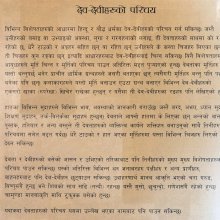Varadabhaya, Varadābhaya, Varada-abhaya: 2 definitions
Introduction:
Varadabhaya means something in Hinduism, Sanskrit. If you want to know the exact meaning, history, etymology or English translation of this term then check out the descriptions on this page. Add your comment or reference to a book if you want to contribute to this summary article.
Images (photo gallery)
In Hinduism
Shaktism (Shakta philosophy)
Source: Google Books: ManthanabhairavatantramVaradābhaya (वरदाभय) refers to “one who bestows boons and freedom from fear”, according to the Kulakaulinīmata verse 3.77-81.—Accordingly, “Tvaritā is without compare and bestows all accomplishments. She is dark blue and her form is that of a (tribal) Śāvarī. She has big, upraised breasts and has two snakes as earrings and two as (her) anklets. She is the three-eyed goddess Tripurā who bestows boons and freedom from fear [i.e., varadābhaya-saṃyutā]. Or else, she has eighteen arms and one should think (of her when engaged) in magical rites. She wears golden clothes and is adorned with a peacock banner. She sits on a lion throne, bestows boons and holds a peacock parasol. She has a peacock bangle and is adorned with a garland of wild flowers. She is adorned with a beautiful peacock diadem”.

Shakta (शाक्त, śākta) or Shaktism (śāktism) represents a tradition of Hinduism where the Goddess (Devi) is revered and worshipped. Shakta literature includes a range of scriptures, including various Agamas and Tantras, although its roots may be traced back to the Vedas.
Shaivism (Shaiva philosophy)
Source: SOAS University of London: Protective Rites in the Netra TantraVaradābhaya (वरदाभय) refers to “granting wishes and safety” (i.e., the hand positions), according to the Netratantra of Kṣemarāja: a Śaiva text from the 9th century in which Śiva (Bhairava) teaches Pārvatī topics such as metaphysics, cosmology, and soteriology.—Accordingly, [verse 3.17-23, while describing a meditation on Amṛteśa in his form as Mṛtyujit]—“And so now, having constructed the amṛtāmudrā or the padmamudrā, [the Mantrin] should meditate on the Ātman. [...] [He is] one-faced, three-eyed, seated on a white lotus, fixed in the bound lotus seat. [He is] four-armed, large-eyed, the hand [fixed in the position] of granting wishes and safety (varadābhaya-pāṇika), [holding] a full moon, radiant, filled with amṛta, holding a water pot, [and] completely full of the world, the moon in his lovely hand. [The Mantrin] should remember him adorned with a reverence that is all white”.

Shaiva (शैव, śaiva) or Shaivism (śaivism) represents a tradition of Hinduism worshiping Shiva as the supreme being. Closely related to Shaktism, Shaiva literature includes a range of scriptures, including Tantras, while the root of this tradition may be traced back to the ancient Vedas.
See also (Relevant definitions)
Partial matches: Varada, Abhaya.
Starts with: Varadabhayahasta.
Full-text: Panchabrahma.
Relevant text
Search found 2 books and stories containing Varadabhaya, Varadābhaya, Varada-abhaya; (plurals include: Varadabhayas, Varadābhayas, abhayas). You can also click to the full overview containing English textual excerpts. Below are direct links for the most relevant articles:
The Linga Purana (by J. L. Shastri)
Chapter 23 - The mode of worship of Siva < [Section 2 - Pūrvabhāga]
Jainism in Odisha (Orissa) (by Ashis Ranjan Sahoo)
Iconography of Jain Gods and Goddess < [Chapter 6]
